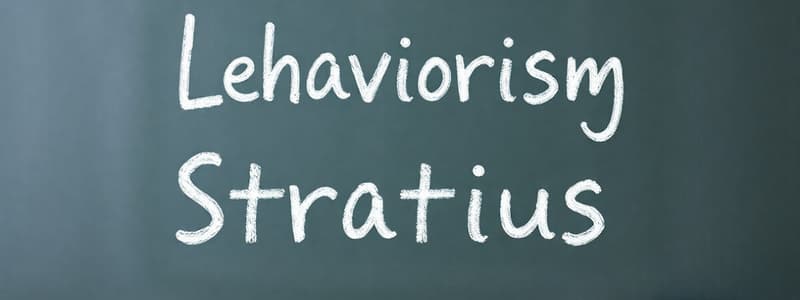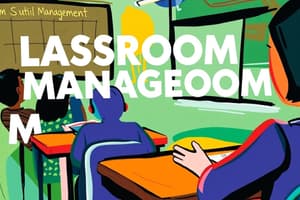Podcast
Questions and Answers
What is the main focus of behaviourism in psychology?
What is the main focus of behaviourism in psychology?
- Unconscious motivations
- Emotional responses
- Cognitive processes
- Observable behaviour (correct)
Which concept describes the decline of a behaviour when it is no longer reinforced?
Which concept describes the decline of a behaviour when it is no longer reinforced?
- Reinforcement
- Extinction (correct)
- Generalisation
- Spontaneous recovery
What type of conditioning does Pavlov’s experiments primarily exemplify?
What type of conditioning does Pavlov’s experiments primarily exemplify?
- Cognitive conditioning
- Operant conditioning
- Classical conditioning (correct)
- Social learning
Which of the following best describes generalisation in behaviourism?
Which of the following best describes generalisation in behaviourism?
According to Watson, how are human and animal learning behaviours viewed in behaviourism?
According to Watson, how are human and animal learning behaviours viewed in behaviourism?
Which term refers to the appearance of a conditioned response after a period during which it was not presented?
Which term refers to the appearance of a conditioned response after a period during which it was not presented?
What role does reinforcement play in behaviourism?
What role does reinforcement play in behaviourism?
Which learning theory focuses on the consequence of behaviour to predict future actions?
Which learning theory focuses on the consequence of behaviour to predict future actions?
What type of learning involves obtaining knowledge through direct experience?
What type of learning involves obtaining knowledge through direct experience?
Which type of reinforcement is characterized by the learner experiencing the consequences of a behavior themselves?
Which type of reinforcement is characterized by the learner experiencing the consequences of a behavior themselves?
Which of the following is a suggested teaching strategy for effective classroom management?
Which of the following is a suggested teaching strategy for effective classroom management?
How should a teacher respond to undesired behaviors in the classroom?
How should a teacher respond to undesired behaviors in the classroom?
Which of these statements best describes observational learning?
Which of these statements best describes observational learning?
What role does the learner play in the traditional behaviorist approach to education?
What role does the learner play in the traditional behaviorist approach to education?
Which theory is NOT typically associated with behaviorism as described?
Which theory is NOT typically associated with behaviorism as described?
What is a primary goal of using reinforcement in the classroom?
What is a primary goal of using reinforcement in the classroom?
What defines operant conditioning in learning?
What defines operant conditioning in learning?
Which of the following is an example of negative reinforcement?
Which of the following is an example of negative reinforcement?
What key aspect does social learning theory emphasize?
What key aspect does social learning theory emphasize?
What role does practice and repetition play in learning according to the content?
What role does practice and repetition play in learning according to the content?
What does 'respondent conditioning' teach an organism?
What does 'respondent conditioning' teach an organism?
Which statement is true about extreme behaviorism according to the content?
Which statement is true about extreme behaviorism according to the content?
What is identified as a method to enhance learning?
What is identified as a method to enhance learning?
Which of the following accurately describes 'punishment' in the context of learning?
Which of the following accurately describes 'punishment' in the context of learning?
Flashcards
Behaviorism
Behaviorism
A school of thought in psychology that focuses on observable behaviors and how they are learned through environmental influences.
Classical Conditioning
Classical Conditioning
A process where a neutral stimulus (bell) is paired with an unconditioned stimulus (food) to elicit a conditioned response (salivation) in an organism.
Generalization
Generalization
A conditioned response (salivation) occurs not only to the specific conditioned stimulus (bell) but also to other similar stimuli.
Reinforcement
Reinforcement
Signup and view all the flashcards
Extinction
Extinction
Signup and view all the flashcards
Spontaneous Recovery
Spontaneous Recovery
Signup and view all the flashcards
Discrimination
Discrimination
Signup and view all the flashcards
Thorndike's Law of Effect
Thorndike's Law of Effect
Signup and view all the flashcards
Observational Learning
Observational Learning
Signup and view all the flashcards
Direct Experience Learning
Direct Experience Learning
Signup and view all the flashcards
Vicarious Reinforcement
Vicarious Reinforcement
Signup and view all the flashcards
Self-Reinforcement
Self-Reinforcement
Signup and view all the flashcards
Self-Regulation
Self-Regulation
Signup and view all the flashcards
Direct Instruction
Direct Instruction
Signup and view all the flashcards
Feedback
Feedback
Signup and view all the flashcards
Teaching 'out of context'
Teaching 'out of context'
Signup and view all the flashcards
Respondent Conditioning
Respondent Conditioning
Signup and view all the flashcards
Operant Conditioning
Operant Conditioning
Signup and view all the flashcards
Positive Reinforcement
Positive Reinforcement
Signup and view all the flashcards
Negative Reinforcement
Negative Reinforcement
Signup and view all the flashcards
Punishment
Punishment
Signup and view all the flashcards
Instructional Design Principles
Instructional Design Principles
Signup and view all the flashcards
Social Learning Theory
Social Learning Theory
Signup and view all the flashcards
Study Notes
Chapter 2: Contributions of Behaviorist Theories to Teaching and Learning
- This chapter explores the contributions of behaviorist theories to teaching and learning.
- Learning objectives include defining behaviorism, explaining different perspectives on behaviorism, outlining learning strategies aligned with various behaviorist proponents, differentiating between different learning theories of behaviorism, and understanding why teachers should be aware of learning styles and diverse teaching approaches.
Behaviorism
- The focus of study is observable behavior.
- The method is objective observation.
- Theoretical explanations are used to analyze a phenomenon until its most basic components are understood.
- Results should be predictable, and both teacher and learner should be able to control the predicted results.
Conditioning Reflex (Pavlov)
- Key Concepts:
- Generalization: After learning a conditioned stimulus, the animal responds similarly to other similar stimuli.
- Reinforcement: The conditioned stimulus is periodically reinforced by the presentation of the unconditioned stimulus.
- Extinction: When the behavior is no longer reinforced, it ceases.
- Spontaneous Recovery: The conditioned response reappears after a period of time, even without further reinforcement.
- Discrimination: The opposite of generalization.
Watson's Behaviorism
- Consciousness is rejected: Observable behavior is the exclusive focus of study.
- Behavior observation is the only acceptable method: for conducting research.
- No difference between human and animal learning: Behaviorism assumes that learning processes are similar in humans and animals.
- Behavior consists of connections: between stimuli and responses.
- Classical conditioning is the most important learning method: Watson emphasized the importance of classical conditioning in learning.
Thorndike's Behaviorism
- Learning occurs through trial and error, and then conditioning.
- Organisms learn in similar ways, as a result of a neural connection between stimulus and response.
- Learning is a matter of trial and error, not insight.
- Repetition and practice are not sufficient.
- Contiguity (occurring together in time) does not fully explain how connections are formed.
Skinner's Behaviorism
- Basic assumptions: All behaviors are determined by scientific laws, behavior can be predicted, and environmental factors fully determine behavior and are significant in controlling behavior
- Respondent conditioning: Teaching or retraining an organism to respond to a new stimulus by repeatedly presenting the new stimulus along with another stimulus that triggers a response is critical.
- Operant conditioning: Behavior is modified through the use of reinforcement following the desired response.
- Positive reinforcement: A positive reward strengthens behavior.
- Negative reinforcement: Strengthens behavior by removing an unpleasant stimulus.
- Punishment: Weakens or removes the response.
- Implications for education: Present learning in small, action-oriented steps. Give quick feedback on learning accuracy. Allow learners to work at their own pace.
Social Learning Theory (Bandura)
- Integrates behaviorism and Gestalt psychology.
- Behavior is learned mainly through environmental and social influences.
- Genetic factors are not considered influential in learning.
- Observational learning: Modeling or watching others and learning from it.
- Self-regulation: Learners control their own behavior based on self-evaluation.
- Three types of learning: Learning through direct experience, observational learning, and self-regulation.
- Three types of reinforcement: Direct, vicarious, and self-reinforcement.
Implications for Teaching and Education
- Teaching strategies: Breaking down information into small learning units, checking learners' work and providing timely feedback, teaching information in a contextual setting, providing repetition, enabling learners to use technology for observational learning, and providing reinforcement.
- Classroom management: Focus on reinforcement schedules, focus on desired behaviors, provide regular feedback to learners.
The Roles of the Teacher and Learner
- The Teacher's Role: Provide stimulus materials and prompts, motivate learners, keep learners participating, provide reinforcement (positive or negative).
- The Learner's Role: Respond to stimuli, experience behavior change, become aware of the learned behavior, and recognize rewards.
Summary
- Key theorists discussed in this chapter include Ivan Pavlov, John B. Watson, Edward Lee Thorndike, Burrhus Frederic Skinner, and Albert Bandura.
- Common to these theories is the belief that learning is a process of reinforcement and reward, with desired responses evident when a learner's behavior changes.
- Information is perceived via prompts from a teacher and then learners respond; this view of learning is considered simplified.
- Many principles of behaviorism can be implemented in the classroom.
Studying That Suits You
Use AI to generate personalized quizzes and flashcards to suit your learning preferences.




